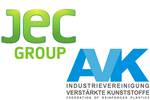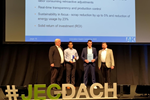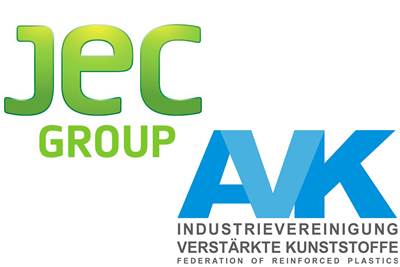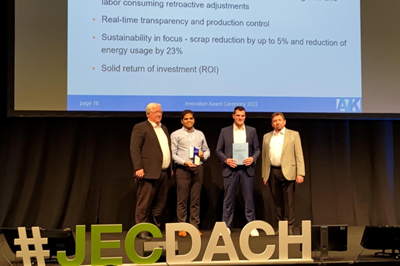Schmidt & Heinzmann camera system awarded 2022 AVK Innovation Award
“Pole Position” uses polarization properties to detect the positioning and orientation of carbon fibers during the cutting and stacking process, reducing waste and enhancing sustainability.
Camera system on cutting and stacking cell. Photo Credit, all images: Schmidt & Heinzmann GmbH & Co. KG
Schmidt & Heinzmann (Bruchsal, Germany) was awarded second place in the “Innovative Processes and Methods” category at this year’s (Augsburg, Germany) Innovation Award, which took place at the JEC DACH Forum at the end of November in Augsburg. The novel camera system, “Pole Position,” which detects the positioning and orientation of carbon fibers, can be used in the automated production of carbon fiber-reinforced polymer (CFRP) components. In the future, the system will be integrated directly into the company’s cutting and stacking cells, which cut fabrics from dry fibers and consolidate the individual layers into a stack.
Until recently, the position and orientation of carbon fiber material in the cutting and stacking process have been measured either with conventional camera systems or by using laser or color sensors. When using conventional camera systems, homogeneous illumination of the recording area is necessary due to the reflection of the carbon fibers, which is difficult to implement, especially with large components. Alternately, laser and color sensors only provide point measurements along the material edge; the uneven edges of the carbon fibers can result in result in significant measurement errors, which also makes this technique unsuitable.
Schmidt & Heinzmann’s camera system takes advantage of the polarization properties of the carbon fibers, which means that the light reflection and absorption of the fibers are irrelevant, the company claims. The system determines the change of intensity with respect to the polarization direction. This relative value can also be determined under changing lighting conditions. A newly developed software then separates the resulting image into polarized and unpolarized areas, enabling the background to be hidden and the component contour to be measured. With an accuracy of ±0.38 millimeter, the system is reported to perform significantly better than conventional systems with an accuracy of ±4 millimeters.
A detailed view of the system.
When using the camera system, users primarily benefit in terms of sustainability, the company notes. Precise contour determination on the NC cutting table allows reduction of edge trimming by up to 85%. When stacking the cuts, the individual layers can be placed on top of each other even more precisely. This exact positioning is a prerequisite for producing preforms with final contour. Therefore, trimming of the components is no longer necessary in the wet compression molding process, for example, which saves 5-10% of the raw materials used (carbon fibers and resin). By eliminating the two process steps “trimming” and “sealing,” investment costs as well as energy costs of these substeps can also be saved.
The announcement makes this the fourth innovation award Schmidt & Heinzmann have received within two years. “We are pleased that another innovation from our product area ‘Cutting & Stacking’ has been awarded,” CEO Matthias Feil says, “especially as the market acceptance for this product is very good so far. The first systems have already been sold, others are in the quotation phase.” Last year, the Cutting & Stacking solutions themselves won the ThinKing Award from the Landesagentur für Leichtbau Baden-Württemberg (State Agency for Lightweight Design), the semi-finished production line “Cube” was selected as a JEC Award finalist and the company itself was named a Top 100 Innovator.
Related Content
Optimized CFRP gantry beam enhances Ultimate cutting machines
CompoTech, Kongsberg PCS collaboration integrates foam-cored design, automated placement of pitch and PAN fibers to achieve award-winning increase in speed and precision.
Read MoreComposite cutting systems are dedicated to material optimization
CAMX 2024: FKgroup showcases its solutions for cutting composite materials, focusing on sustainability and efficiency.
Read MoreAitiip concludes HELACS project with waterjet cutting demonstration
Novel platform involving digital twin and human-robot collaboration succeeded in cutting a component from the 19th section of an A350 wing, highlighting its ability to enable composite structure recycling.
Read MoreComputer-controlled conveyor system improves precision in cutting operations
CAMX 2024: Eastman Machine Co. showcases the Eagle C135, a computer-controlled conveyor and cutting system designed to cut a range of technical and industrial fabrics and composites.
Read MoreRead Next
JEC Group, AVK launch new composites event for the DACH region
JEC Forum DACH, which will take place Nov. 23-24, 2021, will annually highlight and support the composites industry to build business, connect major players and highlight the industry’s dynamics.
Read MoresensXPERT Digital Mold earns 2022 AVK Innovation Award
Data-driven sensor technology optimizes and increases composites manufacturing efficiencies in real time, achieved through collaborative network.
Read MoreUltrasonic welding for in-space manufacturing of CFRTP
Agile Ultrasonics and NASA trial robotic-compatible carbon fiber-reinforced thermoplastic ultrasonic welding technology for space structures.
Read More












